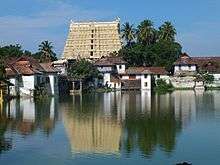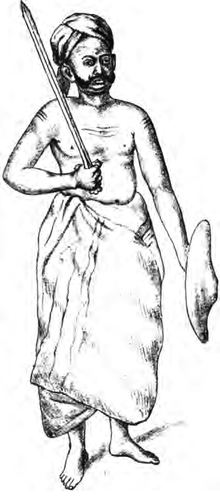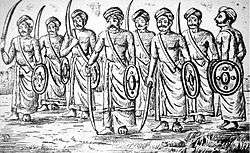Pillai (Nair title)
| പിള്ള | |
|---|---|
 | |
| Regions with significant populations | |
| Kerala | |
| Languages | |
| Malayalam | |
| Religion | |
| Hinduism | |
| Related ethnic groups | |
| Nair, Namboothiri |
Pillai is a title of nobility, which can either refer to a ruling chief and members of the nobility, historically ranked immediately below the king or a title bestowed on Savarna subjects by the ruling families of Kerala for services military or political, most of whom were of Nair origin. Early English records address these hereditary medieval chiefs as the princes of Kerala ranking below the monarch. The most well known are the Pillais of the Eight Noble Houses, the Ettuveettil Pillamar of Travancore.[1] It is from these Chiefs that the matriarchal heads of Travancore Royal Family took their consorts from. After the arrival of the refugee princes of Northern Malabar fleeing the invasion of Tippu Sultan, this practice was dropped and the refugee princes were raised to the status of Koyi Thampuran [2]
Their absolute powers declined since the seizure of power and the creation of the state of Travancore under royal authority by King Marthanda Varma in the 1750s. He went on to create new titles to reward his friends and allies for military or political service rendered. Pillais created before the new state of Travancore was formed by Marthanda Varma are known by their family names and those elevated by Marthanda Varma or after use it as a suffix to their given name.
Medieval chiefs
Medieval Desavazhis of South Travancore who were the Chiefs of Desams (Principalities) possessed this title. They were the rulers of Desams and heads of the Desa-kootams (Principal Councils). Desoms were further divided into Tharas or Karas in South Travancore with a presiding councils called Thara-kootams (Village Councils). In every Desom were four families (Thara-vads or manor-houses) traditionally connected with the administration known by their called Naluvitans (of the four manors). They were considered as the highest subdivision among Nairs of Travancore equal to Samantas/ Kiriyam Nairs of Malabar. They held the rights of seignory and overriding interests with different occupational groups useful to the manor such as the Kammalar in their respective estates.
The Naluvitans of South Travancore held the title of Pillai. They held their titles in perpetuity along with their family names rather than with their personal names. Their family names were derived from the areas they administered. According to Mark de Lannoy, at one time, prominent Pillais included six Nairs, a Brahmin (Pillai Idathara Potti) and a Kshatriya (Pillai Ilampel Pandarathil).[3] The most influential among them were Vanjamutta (identified with modern day- Vanjimuttom),Cuddamon (Kandamam), Barreba and Mandacca (Mondaicaud). The Queen of Attingal (Travancore) would take husbands from among these Lords.[4] The Padmanabhapuram Palace was constructed by a king named Iravi Pillai Iravi Varma Kulasekhara Perumal in A.D. 1601. [5]

After Marthanda Varma's execution of 42 Chiefs, Barons and Nobles [6] according to a noted expert, the title was demoted and came to be granted more commonly to decorate soldiers upon payment of the "Adiyara" from the time of Maharaja Anizham Tirunal Marthanda Varma who had previously subdued the power of the Pillais of the Eight Houses Ettuveettil Pillamar and annexed their territories.[7] This has resulted in the title being rather common rather than only among the highest echelons of Nair society in modern Kerala. The title of Pillai was then on granted to an individual for life upon payment of a fee known as "Adiyara" whose successors including women would be by courtesy titled Pillais. Inspire of this, to subdue the influence of these nobles, Marthanda Varma was to invent more new titles.[7] Pillai became one of the most common titles of dignity held by the Hindu caste of the Nairs of Travancore. The title is equally applicable to women who invariably uses it with their first names. The matriarchal heads of family use the title of "Family Name+ Ammachi"( a corruption of Amma + Shri).
Kanakku
The title was bestowed through a formal ceremony known as Thirumukom Pidikkuka i.e. holding the face of the King and included the payment of a fee known as Adiyara to the King. A person thus bestowed with this title now secured the honorific title of Pillai suffixed and the distinctive title of Kanakku (meaning accountant in malayalam) prefixed to his name. However Kanakku and Pillai were never used together. E.g.: either a person, Krishnan, would be referred to as Krishnan Pillai or Kanakku, followed by his maternal uncle's name, and Krishnan. The latter style was used in royal writs and communications. During the Travancore-Mysore War the forces of Mysore under Tipu Sultan were defeated by a sudden attack under the leadership of General Kali Kutty Nair who was posthumously elevated to the dignity of Pillaidom as Kali Kutty Pillai.
Chempakaraman
A title superior to the ordinary Pillai was that of Kanakku Chempakaraman , an innovation of Maharajah Marthanda Varma of Travancore. The individual whom it was the king's pleasure to honour was first taken in a procession by the nobles and ministers of the state, atop an elephant, around the main four streets of the city of Trivandrum and then received in the palace by the Prime Minister and seated next to him. The ceremony concluded by treating him to Paan Supari. A person thus honoured prefixed Kanakku, followed by Chempakaraman instead of the name of his maternal uncle, followed by his own name, e.g. Kanakku Chempakaraman Krishnan.
Notable people
- Pillais of the 8 noble houses
- Pillai of Pallichal
- Pillai of Kandamukhathu Madom
- Pillai of Sreekanteswaram Virakupura Kotta
- Sir N. R . Pillai, descendant of the Pillais of Nagercoil Elenkath
- Pillai of Meke Pattom
See also
References
- ↑ Lena More,ENGLISH EAST INDIA COMPANY AND THE LOCAL RULERS IN KERALA ISBN_10 8188432040 .
- ↑ Lena More,ENGLISH EAST INDIA COMPANY AND THE LOCAL RULERS IN KERALA Page 22 ISBN_10 8188432040 .
- ↑ Mark de Lannoy,Kulasekhara Perumals of Travancore, Page 6 at para2 .
- ↑ Lena More,ENGLISH EAST INDIA COMPANY AND THE LOCAL RULERS IN KERALA ISBN_10 8188432040 .
- ↑ http://www.keralaculture.org/padmanabhapuram-palace/297.
- ↑ Mark de Lannoy in "Kulasekhara Perumals of Travancore", University of Leiden in 1997
- 1 2 Sardar Kavalam Madhava Panikkar in Malabar & the Portuguese quoted in Aspects of Kerala Social Organisation, Asiatic Society 2014
